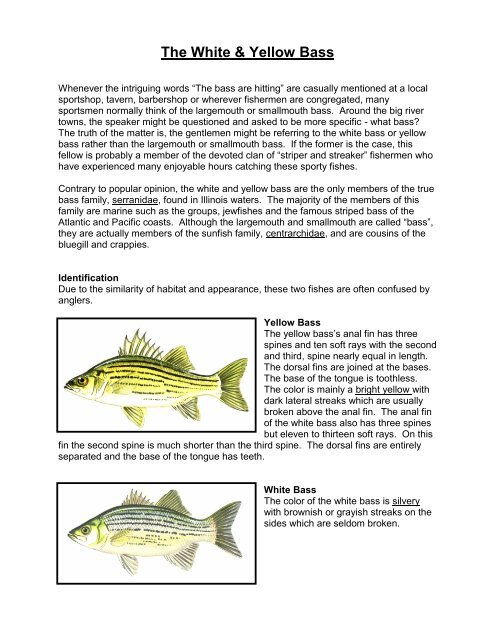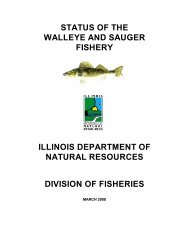The White & Yellow Bass - Fishing in Illinois
The White & Yellow Bass - Fishing in Illinois
The White & Yellow Bass - Fishing in Illinois
You also want an ePaper? Increase the reach of your titles
YUMPU automatically turns print PDFs into web optimized ePapers that Google loves.
<strong>The</strong> <strong>White</strong> & <strong>Yellow</strong> <strong>Bass</strong><br />
Whenever the <strong>in</strong>trigu<strong>in</strong>g words “<strong>The</strong> bass are hitt<strong>in</strong>g” are casually mentioned at a local<br />
sportshop, tavern, barbershop or wherever fishermen are congregated, many<br />
sportsmen normally th<strong>in</strong>k of the largemouth or smallmouth bass. Around the big river<br />
towns, the speaker might be questioned and asked to be more specific - what bass?<br />
<strong>The</strong> truth of the matter is, the gentlemen might be referr<strong>in</strong>g to the white bass or yellow<br />
bass rather than the largemouth or smallmouth bass. If the former is the case, this<br />
fellow is probably a member of the devoted clan of “striper and streaker” fishermen who<br />
have experienced many enjoyable hours catch<strong>in</strong>g these sporty fishes.<br />
Contrary to popular op<strong>in</strong>ion, the white and yellow bass are the only members of the true<br />
bass family, serranidae, found <strong>in</strong> Ill<strong>in</strong>ois waters. <strong>The</strong> majority of the members of this<br />
family are mar<strong>in</strong>e such as the groups, jewfishes and the famous striped bass of the<br />
Atlantic and Pacific coasts. Although the largemouth and smallmouth are called “bass”,<br />
they are actually members of the sunfish family, centrarchidae, and are cous<strong>in</strong>s of the<br />
bluegill and crappies.<br />
Identification<br />
Due to the similarity of habitat and appearance, these two fishes are often confused by<br />
anglers.<br />
<strong>Yellow</strong> <strong>Bass</strong><br />
<strong>The</strong> yellow bass’s anal f<strong>in</strong> has three<br />
sp<strong>in</strong>es and ten soft rays with the second<br />
and third, sp<strong>in</strong>e nearly equal <strong>in</strong> length.<br />
<strong>The</strong> dorsal f<strong>in</strong>s are jo<strong>in</strong>ed at the bases.<br />
<strong>The</strong> base of the tongue is toothless.<br />
<strong>The</strong> color is ma<strong>in</strong>ly a bright yellow with<br />
dark lateral streaks which are usually<br />
broken above the anal f<strong>in</strong>. <strong>The</strong> anal f<strong>in</strong><br />
of the white bass also has three sp<strong>in</strong>es<br />
but eleven to thirteen soft rays. On this<br />
f<strong>in</strong> the second sp<strong>in</strong>e is much shorter than the third sp<strong>in</strong>e. <strong>The</strong> dorsal f<strong>in</strong>s are entirely<br />
separated and the base of the tongue has teeth.<br />
<strong>White</strong> <strong>Bass</strong><br />
<strong>The</strong> color of the white bass is silvery<br />
with brownish or grayish streaks on the<br />
sides which are seldom broken.
Distribution<br />
<strong>The</strong> white and yellow bass are both commonly found <strong>in</strong> the larger rivers, such as the<br />
Ill<strong>in</strong>ois and Mississippi River, their backwaters and adjo<strong>in</strong><strong>in</strong>g bottomland lakes and<br />
major tributaries. Both species are also found <strong>in</strong> some of the natural lakes <strong>in</strong><br />
northeastern Ill<strong>in</strong>ois. Only the white bass is found <strong>in</strong> the Fox Cha<strong>in</strong> O’Lakes. <strong>The</strong><br />
yellow bass is also found <strong>in</strong> many of our farm ponds, city water supply lakes, large<br />
artificial impoundments and natural lakes as a result of natural entry, experimental<br />
stock<strong>in</strong>g or stock<strong>in</strong>g by the public. <strong>The</strong> white bass, while not as widely distributed<br />
throughout the state as the yellow bass, is also commonly found <strong>in</strong> the Great Lakes.<br />
<strong>White</strong> <strong>Bass</strong><br />
<strong>Yellow</strong> <strong>Bass</strong>
Common Names<br />
As is typical of most fishes, they have been given many different names, depend<strong>in</strong>g on<br />
the locale and the fishermen’s fancy. <strong>The</strong> yellow bass’s scientific name is Roccus<br />
Mississippiensis, but his most common nickname is streaker. This fish is also called the<br />
black-striped bass, gold bass, and barfish. <strong>The</strong> white bass is known throughout the<br />
scientific world as Roccus Chrysops. His popular nicknames are striper, silver bass,<br />
striped bass and occasionally, streaker.<br />
Life History<br />
Spawn<strong>in</strong>g of the yellow bass usually takes place <strong>in</strong> April or early May. <strong>The</strong> very small<br />
eggs are deposited over gravel bars, rocky reefs or underwater brush and weeds <strong>in</strong><br />
shallow water. <strong>The</strong>se fish generally mature <strong>in</strong> the third year when they are seven to<br />
n<strong>in</strong>e <strong>in</strong>ches long, but faster grow<strong>in</strong>g fish may mature <strong>in</strong> the second year.<br />
<strong>The</strong> white bass beg<strong>in</strong>s spawn<strong>in</strong>g <strong>in</strong> May or early June when the water temperature is<br />
around 61 degrees F. About one-half of one million eggs are deposited over rocks and<br />
sand and gravel bars near shore, rather than <strong>in</strong> a nest like the bluegill or largemouth<br />
bass. <strong>White</strong> bass <strong>in</strong> large lakes often move upstream to spawn <strong>in</strong> shallow mov<strong>in</strong>g<br />
water. This fish matures <strong>in</strong> the second or third year to a length of 10-12 <strong>in</strong>ches.<br />
<strong>The</strong> white bass is a great traveler. For example, one tagged by fishery scientists at<br />
Lake Chautauqua near Havana, Ill<strong>in</strong>ois, was caught by an angler <strong>in</strong> the Spoon River<br />
eight days later, 30 miles from the po<strong>in</strong>t of release. Another white bass tagged <strong>in</strong> Lake<br />
Pek<strong>in</strong>, M<strong>in</strong>nesota, was caught several months later 140 miles down stream from the<br />
tagg<strong>in</strong>g site.<br />
Foods<br />
<strong>The</strong> first foods eaten by young yellow bass soon after hatch<strong>in</strong>g are microscopic<br />
organisms called plankton, such as m<strong>in</strong>ute crustaceans, small <strong>in</strong>sects, and their larvae.<br />
As the fishes become older and larger, their chief food items are small fishes,<br />
crustaceans, large aquatic <strong>in</strong>sects and their larvae.<br />
Young white bass also live primarily upon these small <strong>in</strong>sects and their larvae, and t<strong>in</strong>y<br />
crustaceans. As they become older, other fishes such as the yellow perch, bluegill,<br />
gizzard shad, and freshwater drum become the most important items <strong>in</strong> their diet. Other<br />
foods eaten are crayfish and larger <strong>in</strong>sects.<br />
Growth<br />
Fisheries scientists can age both the white and yellow bass by count<strong>in</strong>g the number of<br />
annuli or growth r<strong>in</strong>gs on the fish scales. This method is similar to a forester ag<strong>in</strong>g a<br />
tree by the growth r<strong>in</strong>gs, except a fish’s scale must be magnified to identify the yearly<br />
growth marks. Contrary to the belief that fish live for many years, fishery biologists have<br />
proven by extensive collect<strong>in</strong>g and ag<strong>in</strong>g of these fish scales that both species are<br />
relatively short-lived. Very few yellow bass live longer than five years. <strong>The</strong> majority of<br />
white bass have died before they are four years old. Anglers should realize this fact
and fish for these species when they are most abundant because they may die-off by<br />
the follow<strong>in</strong>g year. In the tables listed below, approximate growth rates of the yellow<br />
and white bass are given for the midwestern states.<br />
<strong>Yellow</strong> <strong>Bass</strong><br />
Age <strong>in</strong> years: 1 2 3 4 5 6<br />
Length <strong>in</strong> <strong>in</strong>ches: 3.1 5.8 7.9 9.3 9.9 10.2<br />
Weight <strong>in</strong> ounces: 0.2 1.6 4.3 7.1 8.2 9.7<br />
<strong>White</strong> <strong>Bass</strong><br />
Age <strong>in</strong> years: 1 2 3 4 5 6<br />
Length <strong>in</strong> <strong>in</strong>ches: 5.8 10.2 12.2 14.3 14.8 15.4<br />
Weight <strong>in</strong> ounces: 2.0 8.3 14.0 23.0 27.0 28.5<br />
Stock<strong>in</strong>g<br />
<strong>The</strong> Division of Fisheries does not propagate white and yellow bass <strong>in</strong> its hatcheries<br />
because neither species is well suited to most artificial lakes and ponds <strong>in</strong> Ill<strong>in</strong>ois and<br />
because they are able to ma<strong>in</strong>ta<strong>in</strong> populations with natural reproduction <strong>in</strong> waters where<br />
they are suited.<br />
<strong>White</strong> bass have been experimentally stocked <strong>in</strong> some big impoundments, such as<br />
Lake Spr<strong>in</strong>gfield and Lake Decatur, but without success. Preferr<strong>in</strong>g the deeper waters<br />
of our rivers and large lakes, such as the Mississippi and Great Lakes, the white bass is<br />
out of place <strong>in</strong> small ponds and lakes.<br />
In artificial impoundments the environment is often unsuitable for ma<strong>in</strong>ta<strong>in</strong><strong>in</strong>g a good<br />
yellow bass population; <strong>in</strong> some cases the number of yellow bass become <strong>in</strong>significant<br />
while <strong>in</strong> others too many are produced and the result is stunted fish. Consequently, the<br />
Department of Conservation does not attempt to develop them <strong>in</strong> man-made lakes and<br />
ponds.<br />
Value<br />
<strong>The</strong> white and the yellow bass are both sporty fishes, especially when taken on a fly rod<br />
or light sp<strong>in</strong>n<strong>in</strong>g tackle. <strong>The</strong>y make long determ<strong>in</strong>ed runs to test the angler’s ability,<br />
rather than put up an aerial battle. <strong>The</strong>y are also f<strong>in</strong>e eat<strong>in</strong>g when pan or deep-fat fried.<br />
<strong>The</strong> firm white meat is flaky and very tasty. In some sections of Ill<strong>in</strong>ois, white and<br />
yellow bass make up a very important part of the sport catch. A creel census conducted<br />
on the Mississippi River dur<strong>in</strong>g the summers of 1956 and 1957 showed the white bass<br />
ranged from the fifth to seventh most abundant fish <strong>in</strong> the angler’s catch. At Lake<br />
Chautauqua near Havana, Ill<strong>in</strong>ois, the yellow bass made up over 30 percent of the total<br />
angler’s catch <strong>in</strong> 1950. <strong>The</strong> white bass is not only an important sport fish <strong>in</strong> certa<strong>in</strong>
areas, but is a very important commercial species <strong>in</strong> several of the Great Lakes.<br />
Canadian and American commercial fishermen catch millions of pounds of white bass<br />
each year for the market.<br />
Angl<strong>in</strong>g<br />
<strong>The</strong> majority of yellow bass caught are taken on live baits such as m<strong>in</strong>nows, garden<br />
worms and night crawlers. Cut baits are also very good at times. Occasionally sp<strong>in</strong>nerbaits<br />
or sp<strong>in</strong>ner fly comb<strong>in</strong>ations and small plugs are productive when trolled near the<br />
bottom. When the fish are <strong>in</strong> shallow water, sp<strong>in</strong>ners, spoons, flys and poppers are<br />
effective. <strong>The</strong>se fish generally travel <strong>in</strong> schools, and once located, they are easily<br />
caught by still-fish<strong>in</strong>g with the above natural baits. Best fish<strong>in</strong>g usually occurs <strong>in</strong> the<br />
spr<strong>in</strong>g and early summer around brushy areas and submerged weed beds. Dur<strong>in</strong>g the<br />
heat of summer, fish<strong>in</strong>g is usually poor but picks up after the water cools <strong>in</strong> the fall.<br />
In Ill<strong>in</strong>ois, a favorite spot where white bass are sought is <strong>in</strong> fast water below the locks<br />
and dams on the big rivers. This sporty fish is pursued by fishermen equipped with<br />
cane pole, bait, fly and sp<strong>in</strong>n<strong>in</strong>g equipment. <strong>Fish<strong>in</strong>g</strong> is best <strong>in</strong> the spr<strong>in</strong>g, with m<strong>in</strong>nows<br />
be<strong>in</strong>g the number one bait. Dur<strong>in</strong>g the summer months, experienced anglers keep their<br />
eyes peeled for the telltale signs of schooled white bass feed<strong>in</strong>g near the surface dur<strong>in</strong>g<br />
the early morn<strong>in</strong>g or late afternoon. <strong>The</strong> frenzied activity of these feed<strong>in</strong>g fish causes<br />
the water to swirl or boil. At such times, they may be taken on almost any sp<strong>in</strong>ner-bait<br />
comb<strong>in</strong>ation, small spoons, streamers, small plugs or large dry flies. <strong>The</strong> ma<strong>in</strong> th<strong>in</strong>g to<br />
remember at this time is to keep the bait on or near the surface of the water. Dur<strong>in</strong>g the<br />
day, these fish are generally caught <strong>in</strong> the deeper waters, from six to ten <strong>in</strong>ches from<br />
the bottom, us<strong>in</strong>g a sp<strong>in</strong>ner-bait or sp<strong>in</strong>ner-fly comb<strong>in</strong>ation or still fish<strong>in</strong>g with m<strong>in</strong>nows.<br />
It is surpris<strong>in</strong>g but also regrettable that these two f<strong>in</strong>e game fishes are not better known<br />
and more sought by Ill<strong>in</strong>ois anglers. Although the yellow bass is widely distributed<br />
throughout the state and the white bass has been taken commercially for many years<br />
from the Great Lakes, it has not been until the last ten to twenty years that the white<br />
bass has ga<strong>in</strong>ed angl<strong>in</strong>g fame. When the large man-made lakes were constructed <strong>in</strong><br />
the southern states such as Tennessee, Oklahoma, Kentucky and Missouri, white bass<br />
were established and produced tremendous fish<strong>in</strong>g which quickly and permanently<br />
captured the angler’s hearts. An <strong>in</strong>terest<strong>in</strong>g po<strong>in</strong>t to mention is that <strong>in</strong> many cases, after<br />
these big broods gave the anglers such phenomenal fish<strong>in</strong>g, the white bass virtually<br />
disappeared until another large brood was successfully produced.














